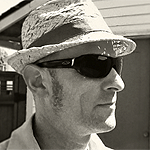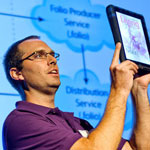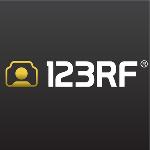Design for the Web. Better.
Meet the interactive designers, developers and programmers behind blockbuster web design projects for Quora, Twitter, the Sundance Film Festival, Fitbit, eBay, the Olympics and more. They’ll demystify complex concepts, share design processes you can apply to your own work, and clue you in to the web design trends and tools you need to know about. All with the trademark friendly content, networking and inspiration you expect from the team that created HOW Design Live.
Who
What
Monday, November 17
Registration Opens
Music's Visual Future / Scott Snibbe - less
What is the successor to the LP, MTV, and YouTube? How will music meld with video, graphics, and interactivity? And will any of it make money? Snibbe will present some history, and current examples of interactive and visual digital music experiences, along with the debut of Eyegroove, a new social visual music platform that will be released around the time of this talk.
Scott Snibbe is an entrepreneur and media artist, founder of Eyegroove and Snibbe Interactive. His award-winning music apps have featured collaborations with Björk, Beck, Philip Glass, Metric, and Passion Pit. He was one of the early developers of Adobe After Effects, a pioneer in gesture-based interactive experiences, and is a renowned innovator in interactive art and human-computer interaction research.
Rolling Up Our Responsive Sleeves / Ethan Marcotte- less
WLearn strategies for handling trickier elements of responsive design that’d make even the most seasoned designer quail: stuff like advertising, complex layouts, deep navigation patterns, third-party media, and, yes, actual, honest-to-goodness content.
We’ve discussed at length the fundamentals of responsive design, combining fluid grids and media queries to create more flexible, device-agnostic sites. So does that mean responsive design is a magic formula that solves all our problems? Well, no. But thankfully, we didn’t get into web design because we wanted to be bored.
3 Main Takeaways:
- Learn the fundamentals of responsive design.
- Get strategies for tackling technical challenges in a responsive layout.
- Walk away with a framework for discussing design changes in a responsive layout.
How To Iterate / David Cole- less
This talk by David Cole will explain how to improve products after they're launched, going beyond the MVP.
Iterative product development is increasingly common these days, and the design process is evolving in response. In this session, David will provide a framework for organizing the design process, taking full advantage of modern methods and technology.
Topics will include working with data and research, prioritization, developing ideas, validating hypotheses, testing, and more.
Habitual Creativity / Jim Krause- less
Habitual creativity? Yes. Why? Because finding non-work-related creative outlets that are enjoyable and instructive is a great way of continually reminding ourselves that making stuff is fun (something we can easily forget in the midst of our deadline-driven professions)—while also expanding our skills and making us better at what we do. This quick session runs through a tidy list of reality-tested projects that you might want to add to your repertoire of constructive habits—projects that may not only have a positive effect on your professional work, they’ll also give you a whole new set of constructive alternatives to watching time go up in smoke while sitting in front of the TV or cruising the internet.
3 Main Takeaways:
- Learn creatively beneficial habits that you can fit into tiny spaces in your daily routine.
- Get lots of reminders of the connection between enjoying what we do for a living and career longevity.
- Absorb encouragement to use whatever skills you currently possess to try out new creative venues of all kinds.
Lunch on Your Own
Interviewing Users: Uncovering Compelling Insights / Steve Portigal- less
Find out how to interview users to mine the most useful and accurate information for your design.
Interviewing users is undeniably one of the most valuable and commonly used user research tools. Yet sometimes we forget that in order to gain the most useful insights, we need to continually practice and develop this skill. People tend to “wing it” and without good interviewing skills, insights may be inaccurate or reveal nothing new, suggesting the wrong design or business responses
This session will look at how to frame the research problem so it has the most impact on the team and their design. Steve Portigal will explore the importance of rapport-building, offer new listening techniques and review different types of questions and question types. He’ll also devote some time to discussing what type of participants to recruit and how to find them.
3 Main Takeaways:
- Framing a research problem.
- User insights to drive innovation, not just evaluation.
- How to ask open-ended generative questions.
Spanning the World: Designing for Multiple Platforms / Nick Myers- less
Learn how to create a multi-platform system that supports many diverse human needs and different contexts. Hear how to design complex features across multiple devices that interact seamlessly together. And learn how to help people have a better, smarter experience across their world.
Bits and Pieces: A Systems Approach to Web Design for Brands / Indhira Rojas- less
Find out how you can approach web design to support and enable continuous brand and product development.
Digital brands are dynamic, each aspect in constant iteration and evolution. In this session, Indhira Rojas will cover different case studies and work strategies that utilize a systems thinking approach to web design. She’ll also offer tips on using style guides and pattern libraries to accelerate the web design process and enable brand and product documentation.
3 Main Takeaways:
- Learn how a systems approach to web development leads to more effective product/brand development.
- Find out how to use style guides and pattern libraries to document the components of the product or brand, enabling iteration and a shared resource.
- Discover how these principles can be effective and beneficial for small projects as well as complex brands with many components.
Embrace the Fear: Creatively Recalculating Your Daily Design Routine / Von Glitschka - less
3 Main Takeaways:
- Demystify fear so that you gain a practical understanding of it.
- Get actionable strategies for pushing through fear and intimidation to do your best work.
- Get inspired to think at a higher level.
Happy Hour! sponsored by Hoefler & Co.
Tuesday, November 18
Registration Opens
Breakfast Table Topics and/or Speed Coaching - less
Orchestrating Content / Sara Wachter-Boettcher - less
Templates, trainings, threats: Sara Wachter-Boettcher has tried everything to get content from clients sooner—and mobile hasn’t made things easier. But in this talk, she’ll teach you practical approaches and activities anyone can use to bring harmony to the content process.
Instead of planning pages, now we’re asking stakeholders to prioritize and manage a million bits of modular content. So how do we keep our subject-matter experts from feeling overwhelmed, prevent carousel-obsessed executives from endless homepage arguments, and get the content we need to make design and development decisions?
The answer is in using content strategy as a means to orchestrate, not dictate. Orchestra conductors don’t control all the instruments or the people playing them. Instead, they:
- Unify performers. Learn how to get your ensemble cast of content producers rallied around shared priorities and goals from the start—and see how understanding their politics and processes can improve design and development, too.
- Listen and shape. Having a great ear will help you hear problems sooner, so you can better allocate time and resources to the areas that will most shape the content’s overall quality.
- Keep the tempo. It’s hard to focus on the notes in front of you and think about where the song is heading. Learn to help your players stay focused on the details, while showing them how their part helps the whole piece come together.
Presentation Presentation / Michael Kruzeniski - less
Giving presentations is an activity that many designers do not enjoy, so it is often avoided, not practiced, and scheduled only when absolutely necessary. It is however, an important skill for any designer working with clients, collaborating with other designers, engineers and product managers, and for communicating work with leadership in a company.
Giving effective presentations is a critical tool for building support around projects, maintaining momentum, and seeing it through to completion. While the vast majority of your time as a designer will be spent on the craft of design — exploring, sketching, and iterating on design problems — the success of your work will depend on your ability to present that work in a clear and compelling form at the right time to the right people. In this session, you will learn:
- The importance and value of being good at giving presentations, and having a design team that is good at giving presentations.
- The habits and practices necessary to become better at giving presentations.
- How to plan a presentation roadmap to build momentum over the course of a project and get feedback at critical decision points.
- How to structure presentations to funnel your audience towards your decision point.
- How to use scenarios to put your audience in the mindset of your user.
- Formats for effective and immersive presentations at the different stages of the design process.
- The habits and practices necessary to become better at giving presentations.
- How to plan a presentation roadmap to build momentum over the course of a project and get feedback at critical decision points.
- Formats for effective and immersive presentations at the different stages of the design process.
Designing for Positive Behaviors and Habits / David Sherwin - less
Explore a growing trend in the interactive space— apps and services that responsibly encourage behavior change in users—and discover the tools and techniques you can use to create them.
We live in a world where we expect the applications and services we use every day to not only help us do what we want to do, but encourage us to change our behavior in ways that will make us healthier, wealthier, and happier. David Sherwin, Director of User Experience at Lynda.com, will explore this growing trend in the interactive space, where designers are using techniques drawn from the social sciences to support (or nudge) the choices their users make. You’ll walk away from this session with a new vocabulary and tools you can use to plan, construct, and test design solutions intended to change user behavior in a responsible manner.
3 Main Takeaways:
- Find out what people mean when they say they are designing for behavior change.
- Explore the tools and techniques designers are using to design for behavior change.
- Learn how an interactive designer can responsibly encourage behavior change.
Lunch on Your Own
Adobe Workshop / Brian Wood - less
Get hot tips for working faster with Photoshop, Illustrator and InDesign. Whether you work mostly on print projects, or you’re more of a jack-of-all-trades, the one thing we all have in common is that there just aren’t enough hours in the day. This workshop will deliver a litany of hot tips in the latest versions of Photoshop, Illustrator and InDesign that guarantee to save you time.
Here’s just some of what you’ll learn:
Photoshop CC
- Font workflow improvements: The frustrations of “missing font” errors have been eliminated, along with a lot of the time and effort spent managing fonts. And adding new fonts is easy, now that you can simply click to select and add fonts from the Typekit website.
- Smarter Smart Guides: Easily see the distance and alignment between two objects, and Smart Guides will snap when distances between sets of objects match.
- Improved Layer Comps: The Layer Comps panel has been redesigned to show which attributes each layer comp controls, and you can sync changes to multiple Layer Comps.
Illustrator CC
- Live Shapes: You can create and control the dimensions and radii of rectangles and rounded rectangles dynamically, either with on-art controls, or by entering precise numbers in the Transform panel.
- Pen tool preview: You can preview your drawing before you commit to dropping a point, reducing the need to tweak your creations later.
- Anchor Point enhancements: You can now make anchor point handles unequal, repair broken handles, have better control when closing paths, and reposition the closing point on the fly.
InDesign CC
- Simplified tables: Easily move columns and rows in tables where you want them, by simply selecting, dragging, and dropping.
- Fixed Layout EPUB: Make interactive EPUB books with live text — such as children’s books, cookbooks, travel books, and textbooks — that are rich with illustrations, photos, audio, video, or animations.
- Color Groups: Manage and organize your color swatches in any way that makes sense for your projects.
This session is best suited for designers who spend most of their day using Photoshop, llustrator and InDesign. Adobe products used—Illustrator, InDesign, Photoshop, Typekit desktop fonts, and Kuler—are all available as part of an Adobe Creative Cloud membership.
Fumbling Into The Future / Stephen Anderson - less
The role of UX designers is changing as experiences move off screen and spread into the physical world. From wearable tech to problems of understanding, we’re puzzling out solutions as we go. We need a set of skills—human skills—we can call on to solve the right problems.
As information is pushed out to more devices, today’s design space bridges the physical and digital. We need to consider how the entire customer experience works across touchpoints. We must develop skills that consider context, coordination, and brave new world of connected devices.
Stephen’s talk will describe:
- Context and Coordination—How do we design for experiences that span people, artifacts, and environments?
- Connected Devices—Disruptive experiences will get devices and sensors to talk seamlessly to each other. What’s needed to design for these devices?
- Interaction Techniques—What are interaction patterns universally present in GUIs, touchscreens, wearables, and whatever the future throws at us? And how do these interactions lead to understanding?
Web Design: The First Hundred Years / Maciej Ceglowski - less
Join Maciej Ceglowski for an insightful look “back” at web design’s beginnings, from the perspective of someone 100 years in the future. You’ll see how the web is evolving in ways nobody expected, and how you can design with the future in mind.
It’s normal for a new medium to be in a state of flux, but the situation is particularly acute for those of us working online, since the constraints we work under are not physical. The medium changes whenever the code changes, and the code changes all the time. What lessons can we take from other media about how to manage this dizzying rate of change? And how can we hope to do lasting work in a medium so obsessed with novelty? Enjoy this report from the year 2110 on attempts to reconstruct what the early web must have looked like.
3 Main Takeaways:
- Hear lessons from other mediums about how to manage web design’s constant change.
- Get ideas for doing work that lasts, despite the medium’s obsession with novelty.
- Look at web design from a whole new angle and experience some “a-ha” moments.
Low-Tech Fuel for High-Test Creativity / Sam Harrison - less
To keep our creativity powerful and plentiful, we have to sometimes step away from technology and interact with what’s inside us and what’s all around us. Popular HOW speaker Sam Harrison reenergizes us after a busy day with five foolproof factors to fire up our creative hard drives.
Happy Hour! sponsored by Campaign Monitor.
Wednesday, November 19
Registration Opens
Breakfast Table Topics and/or Speed Coaching - less
The Future of Web Design / Christopher Butler - less
This session with Chris Butler will put you ahead of the trends in web design so that you can position yourself for success.
It's time we reframed our entire concept of web development. First, in terms of widening the scope of what websites do today and second, in terms of understanding what web development as a discipline is becoming. Sophisticated web development is no longer about creating discreet applications, but doing information logistics.
In this session, Chris will explore the history and trajectory of web design and development and offer a glimpse of things to come.
3 Main Takeaways:
- Front-end design techniques are stabilizing and are headed toward commoditization.
- As web platforms become more complex, the use of APIs is becoming more central to web development. This is where information logistics comes in...
- Designers can position themselves around the change. This session will cover how...
Creative Bootcamp / Stefan Mumaw - less
We typically think of creativity as an external force that we don’t control or an artistic talent that we don’t have. The reality is that creativity is a procedural, programmable characteristic of problem solving. It is a habit, and as such, creativity can be trained. We can improve creatively. All of us generate ideas and we do it every day. If creativity truly is a habit, if it’s a skill that we can perform, that means we can control our own creative improvement. And Creative Boot Camp author and Callahan Creek Creative Director Stefan Mumaw is going to prove it to you. He’ll not only show you what makes us all creative and what simple changes in our creative lives can have the greatest effect, he’ll run you through a series of creativity exercises that will prove that a few small creative steps will have you generating ideas in greater quantity and quality. Stefan will elaborate on the key characteristics of daily creative output, identifying the obstacles to effective creative training and breaking down ideation into digestible steps, all the while using short, in-your-seats creative exercises to illuminate key points about behavior, experience and perspective. From serious creative inflection to comedy improv techniques, the audience is taken on a creative journey through practice, philosophy and application.
Lunch on Your Own
Build. Better. Content! / Jonathon Colman - less
Let Facebook Content Strategist Jonathon Coleman teach you how to build useful products with great content.
Web sites, blogs, and social presences often aren’t enough to keep your audience engaged because we’ve entered the age of apps, where content is a product in and of itself. But how do you take the next step to build content-first products and apps? This is a job for content strategy.
3 Main Takeaways:
- Think beyond your web site to build content-first products and apps.
- Learn about tools and techniques for integrating content strategy at every stage of the product design process.
- See and review examples of content products developed at Facebook.
Tall Tales from a Large Man / Aaron Draplin - less
Using scientific proof and state-of-the-art multimedia techniques, Aaron James Draplin of the Draplin Design Co. delivers a sucker punch of a talk that aims to provide bona fide proof of work, the highs and lows of a ferociously independent existence and a couple tall tales from his so-called career in the cutthroat world of contemporary graphic design. Just a regular guy with a trajectory a little dirtier than yours, his talk is open to all oncomers brave enough to show up. If you are a youngster, you may find yourself inspired to attack your design future in a different way. If you are established, you may just leave feeling grateful you don't have anything to do with him. Hard to say. Be there!
3 Main Takeaways:
- Bigger isn't always better.
- What really matters: Paychecks? Billable hours? Prestige? Nope.
- You can build the exact life you want.
Thanks for coming to HIDC!
“You've finally given me the courage to design my own site!”
– Anna P., Davidson, NC
Where
Hilton San Francisco Union Square
333 O'Farrell Street • San Francisco, CA 94102
Located in the heart of downtown San Francisco, this stylish and sophisticated hotel offers easy access to Nob Hill, Chinatown and fantastic shopping, dining and entertainment opportunities at Union Square.
Discounted hotel rooms are available for HIDC attendees in San Francisco while they last.







